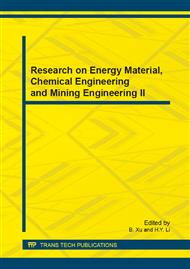[1]
J.Y. Liu, Q. Qiao, L. Chang, etc., Service Life of Tire and Amount of Waste Tire Forecast in China, China Resources Comprehensive Utilization. Vol. 29 (2011) No. 10, p.34.
Google Scholar
[2]
R. Helleur, N. Popovic, M. Ikura, etc., Characterization and Potential Applications of Pyfolytic Char from Ablative Pyrolysis of Used Tires, Journal of Analytical and Applied Pyrolysis, Vol. 58-59 (2001), p.813.
DOI: 10.1016/s0165-2370(00)00207-2
Google Scholar
[3]
Y.R. Ang, L. Jie and B.C. Chen. Surface Characteristics of Carbon Black Produced by Pyrolysis of Used Tires. Acta Scientiae Circumstantiae, Vol. 22 (2002) No. 5, p.637.
Google Scholar
[4]
R. Helleur, N. Popovic, M Ikura, etc., Characterisation and Potential Applications of Pyrolytic Char from Ablative Pyrolysis of Used Tires. Journal Analytical Applied Pyrolysis, Vols. 58-59 (2001), p.813.
DOI: 10.1016/s0165-2370(00)00207-2
Google Scholar
[5]
N.K. Hamadi, X.D. Chen, M.M. Frid, MGQ Lu. Adsorption Kinetics for the Removal of Chromium (Ⅵ) from Aqueous Solution by Adsorbents Derived from Used Tires and Sawdust. Chem Eng J, Vol. 84 (2001), p.95.
DOI: 10.1016/s1385-8947(01)00194-2
Google Scholar
[6]
V. K. Gupta, Bina Gupta, Arshi Rastogi, etc. Pesticides Removal from Waste Water by Activated Carbon Prepared from Waste Rubber Tire. Water Research, Vol. 45 (2011), p.4047.
DOI: 10.1016/j.watres.2011.05.016
Google Scholar
[7]
Allen JL, Gatz JL, Eklund PC. Applications for Activated Carbons from Used Tires: Butane Working Capacity. Carbon, Vol. 37 (1999), p.1485.
DOI: 10.1016/s0008-6223(99)00011-1
Google Scholar
[8]
Teng H, Lin YU, Hsu LY. Production of activated carbons from pyrolysis of waste tires impregnated with potassium hydroxide. J Air Waste Manage Assoc Vol. 50 (2000), p. (1940).
DOI: 10.1080/10473289.2000.10464221
Google Scholar
[9]
Edward L.K. Mui, Danny C.K. Ko, Gordon Mckay. Production of active carbons from waste tires-a review. Carbon, Vol. 42 (2004),: p.2789.
DOI: 10.1016/j.carbon.2004.06.023
Google Scholar
[10]
Eric M. Suuberg, Indrek Aarna. Porosity Development in Carbons Derived from Scrap Automobile Tires. Carbon, Vol. 45 (2007), p.1719.
DOI: 10.1016/j.carbon.2007.05.012
Google Scholar
[11]
E. Manchon-Vizuete, A. Macias-Garcia, A. Nadal Gisbert, et al. Preparation of Mesoporous and Macroporous Materials from Rubber of Tyre Wastes. Microporous and Mesoporous Materials. Vol. 67 (2004), p.35.
DOI: 10.1016/j.micromeso.2003.10.002
Google Scholar
[12]
E. Manchon-Vizuete, A. Macias-Garcia, A. Nadal Gisbert, et al. Preparation of Mesoporous and Macroporous Materials from Rubber of Tire Wastes. Microporous and Mesoporous Materials. Vol. 67 (2004), p.35.
DOI: 10.1016/j.micromeso.2003.10.002
Google Scholar
[13]
B.X. Shen, F Lu, G.Y. Zhu, etc. Characterization of Modified and Original Carbon Blacks from Pyrolysis of Scrap Tires. Chinese Journal of Environmental Engineering. Vol. 4 (2010), No. 7, p.1615.
Google Scholar
[14]
Edward L.K. Mui, W.H. Cheung, Gordon Mckay. Tire Char Preparation from Waste Tire Rubber for Dye Removal from Effluents, Journal of Hazardous Materials, Vol. 175(2010), p.151.
DOI: 10.1016/j.jhazmat.2009.09.142
Google Scholar


